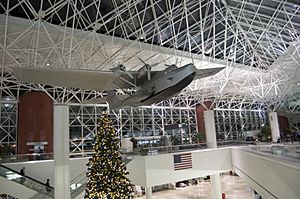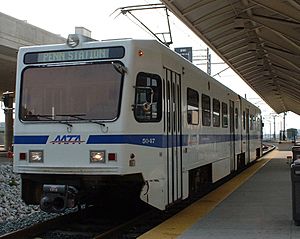Baltimore/Washington International Airport facts for kids
Quick facts for kids
Baltimore/Washington International Thurgood Marshall Airport
|
|||||||||||||||||||
|---|---|---|---|---|---|---|---|---|---|---|---|---|---|---|---|---|---|---|---|
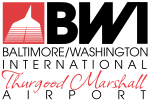 |
|||||||||||||||||||
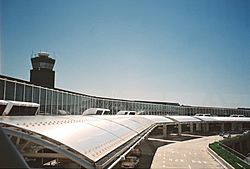
The airport's main terminal in May 2009
|
|||||||||||||||||||
| Summary | |||||||||||||||||||
| Airport type | Public | ||||||||||||||||||
| Owner/Operator | Maryland Aviation Administration (MDOT MAA) | ||||||||||||||||||
| Serves |
|
||||||||||||||||||
| Location | Anne Arundel County, Maryland, U.S. | ||||||||||||||||||
| Opened | June 24, 1950 | ||||||||||||||||||
| Elevation AMSL | 143 ft / 44 m | ||||||||||||||||||
| Coordinates | 39°10′31″N 76°40′06″W / 39.17528°N 76.66833°W | ||||||||||||||||||
| Map | |||||||||||||||||||
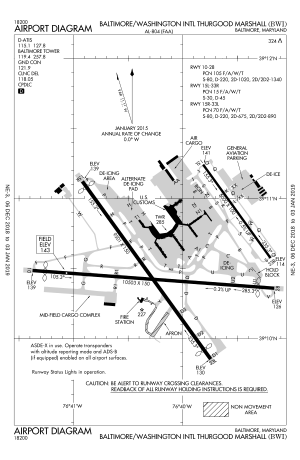 FAA airport diagram |
|||||||||||||||||||
| Runway | |||||||||||||||||||
|
|||||||||||||||||||
| Statistics (2023) | |||||||||||||||||||
|
|||||||||||||||||||
|
Sources: BWI Airport
|
|||||||||||||||||||
Baltimore/Washington International Thurgood Marshall Airport (BWI) is a big airport in Anne Arundel County, Maryland, USA. It's about 9 miles (14 km) south of downtown Baltimore and 30 miles (48 km) northeast of Washington, D.C..
BWI is one of three main airports that serve the Washington–Baltimore metropolitan area. The other two are Dulles International Airport (IAD) and Ronald Reagan Washington National Airport (DCA).
This airport is a major hub for Southwest Airlines. In 2023, BWI had over 26 million passengers, making it the busiest airport in the Baltimore-Washington area. It was ranked #23 for passenger numbers in the U.S.
In 2005, the airport was named after Thurgood Marshall. He was born in Baltimore and was the first African American to become a U.S. Supreme Court justice.
Contents
History of BWI Airport
Building a New Airport

Plans for a new airport began in 1944, near the end of World War II. Officials decided the best spot was a large area of land near Linthicum Heights, Maryland. This location was chosen because it was close to downtown Baltimore and major train lines.
Construction started on May 2, 1947. To build the airport, some land was bought from a church, and 170 graves from a cemetery were moved. A road, Baltimore–Fort Meade Road, was also moved.
Friendship International Airport Opens
The airport, first called Friendship International Airport, opened on June 24, 1950. President Harry S. Truman himself came for the dedication! The total cost to build it was $15 million.
A month later, airlines moved their flights from the old Baltimore Municipal Airport to the new Friendship Airport. The very first scheduled flight, an Eastern Airlines plane, arrived on July 23, 1950, at 12:01 AM.
In the 1950s, the airport started offering jet service. Since other nearby airports couldn't handle the big new jets, Friendship became important for jet flights in the Washington, D.C. area for a while. By 1963, it had a long runway that could handle any commercial jet.
Becoming Baltimore/Washington International
In 1972, the Maryland Department of Transportation (MDOT) bought the airport. They immediately started plans to make it better and more modern.
On November 16, 1973, the airport changed its name to Baltimore/Washington International Airport. This was done to attract more passengers from the Washington, D.C. area. Its airport code also changed from BAL to BWI in 1980.
In 1979, a big renovation project finished, making the terminal much larger and increasing the number of gates from 20 to 27.
Connecting by Train
In 1980, the BWI Rail Station opened. This was a big deal because BWI was the first airport in the U.S. to have its own train station connecting passengers to other cities like Washington, D.C., and Baltimore.
Growth and New Airlines
In the 1990s, a new international terminal (Concourse E) was added. Also, one of the runways was made longer so it could be used by smaller passenger jets.
Since the 1990s, BWI has become very popular for low-cost airlines, especially Southwest Airlines. Southwest started flying from BWI in 1993 and has grown a lot since then. Today, Southwest is the airport's biggest airline, carrying more than half of all passengers.
21st Century Changes
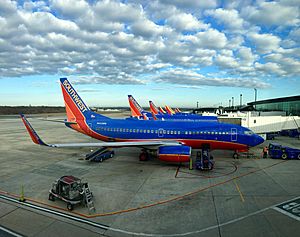
In 2005, Concourses A and B were expanded and updated to handle all of Southwest Airlines' flights. On October 1, 2005, the airport was officially renamed Baltimore/Washington International Thurgood Marshall Airport to honor the famous Supreme Court Justice.
BWI has received awards for its service. In 2008, Health magazine called BWI the second-healthiest airport in the U.S. In 2009, it was ranked the world's top airport in its size category for service quality.
In 2014, one of the airport's runways, 04–22, was permanently closed. It was mainly used when the main runways needed repairs.
In 2016, the airport started a cool partnership with Towson University's WTMD radio station, hosting a concert series right in the baggage claim area!
In 2018, construction began on a $60 million expansion for Southwest Airlines, which opened in 2021. That year, BWI also set a new record with over 27.1 million passengers.
Recently, BWI has added more international flights. For example, Play Airlines and Icelandair now fly daily to Reykjavík, Iceland. In 2023, Copa Airlines started direct flights to Panama City, making it the first airline from Central America to fly from BWI.
Airport Facilities
Runways
BWI Airport is a big place, covering about 3,160 acres (12.8 square kilometers). It has three active runways:
- 10/28: 10,503 feet (3,201 meters) long. This is the main runway for taking off.
- 15R/33L: 9,501 feet (2,896 meters) long. This is the main runway for landing.
- 15L/33R: 5,000 feet (1,524 meters) long. This runway is mostly used by smaller planes and for general aviation. It was made longer in the 1990s.
Terminal Building
Baltimore/Washington International Airport has five main areas called concourses, with a total of 78 gates. Some of these gates are used for international flights.
- Concourse A/B has 30 gates and is used only by Southwest Airlines.
- Concourse C has 14 gates and is used by Southwest, American, and Contour Airlines.
- Concourse D has 23 gates and is used by most other domestic airlines and Air Canada.
- Concourse E has 11 gates and is used for all international flights.
Cargo Area
The airport also has a large area for cargo planes, covering about 395,000 square feet (36,700 square meters). This includes a big warehouse used by Amazon Air for shipping packages.
Getting to and from BWI
BWI is known for being easy to get to. It's located right off a highway that connects to major interstates like I-95. The airport has many parking options, from garages close to the terminals to remote lots with shuttle buses.
- Light Rail: A light rail station is right next to Concourse E, offering rides to downtown Baltimore.
- Train Station: The BWI Rail Station is about a mile from the terminal, but free shuttle buses take you there. From this station, you can catch Amtrak and MARC trains to places like Washington, D.C., and Baltimore. BWI was the first U.S. airport with its own intercity train station!
- Buses: Local buses also stop at the airport terminal, connecting to other areas.
- Shuttles and Taxis: You can also find private cars, rental cars, taxis, and shuttle services to many locations.
Other Cool Spots
- BWI Business District: This area around the airport has many businesses and hotels, including the BWI Rail Station and the BWI Rental Car Facility.
- Aircraft Observation Area: In the early 1990s, BWI opened the Thomas A. Dixon Aircraft Observation Area at Friendship Park. It's a great spot for watching planes land and take off, with a playground nearby. You can see several planes at once!
Airlines and Destinations
Passenger Flights
| Airlines | Destinations | Refs |
|---|---|---|
| Alaska Airlines | Seattle/Tacoma | |
| Allegiant Air | Asheville, Destin/Fort Walton Beach, Sarasota (ends October 28, 2024), Savannah Seasonal: Knoxville, Punta Gorda (FL) |
|
| American Airlines | Charlotte, Chicago–O'Hare, Dallas/Fort Worth, Miami | |
| American Eagle | Charlotte, Chicago–O'Hare Seasonal: Miami |
|
| Avelo Airlines | Seasonal: New Haven, Wilmington (NC) | |
| BermudAir | Bermuda | |
| British Airways | London–Heathrow | |
| Condor | Seasonal: Frankfurt | |
| Contour Airlines | Macon/Warner Robins (GA) | |
| Copa Airlines | Panama City–Tocumen | |
| Delta Air Lines | Atlanta, Detroit, Minneapolis/St. Paul, Salt Lake City | |
| Delta Connection | Boston, New York–JFK | |
| Frontier Airlines | Atlanta, Charlotte, Chicago–Midway, Cleveland, Dallas/Fort Worth, Detroit, Miami, Orlando, San Juan Seasonal: Denver, Tampa |
|
| Icelandair | Reykjavík–Keflavík | |
| Play | Reykjavík–Keflavík | |
| Southwest Airlines | Albany, Albuquerque, Aruba, Atlanta, Austin, Birmingham (AL), Boston, Buffalo, Cancún, Charleston (SC), Charlotte, Chicago–Midway, Chicago–O'Hare, Cincinnati, Cleveland, Colorado Springs, Columbus–Glenn, Dallas–Love, Denver, Destin/Fort Walton Beach, Detroit, Fort Lauderdale, Fort Myers, Grand Rapids, Greenville/Spartanburg, Hartford, Houston–Hobby, Indianapolis, Jackson (MS), Jacksonville (FL), Kansas City, Las Vegas, Long Island/Islip, Los Angeles, Louisville, Manchester (NH), Memphis, Miami, Milwaukee, Minneapolis/St. Paul, Montego Bay, Myrtle Beach, Nashville, New Orleans, Norfolk, Oakland, Orlando, Phoenix–Sky Harbor, Pittsburgh, Portland (ME), Providence, Punta Cana, Raleigh/Durham, Richmond, Rochester (NY), Salt Lake City, San Antonio, San Diego, San José (CR), San Juan, Sarasota, Savannah, St. Louis, Syracuse (ends August 4, 2024), Tampa, West Palm Beach Seasonal: Belize City, Grand Cayman, Liberia (CR), Nassau, Panama City (FL), Pensacola, Providenciales, San José del Cabo, Seattle/Tacoma |
|
| Spirit Airlines | Atlanta, Boston, Cancún, Charleston (SC) (begins August 14, 2024), Dallas/Fort Worth, Fort Lauderdale, Houston–Intercontinental, Las Vegas, Los Angeles, Miami, Milwaukee (begins August 14, 2024), Myrtle Beach, New Orleans, Orlando, Portland (OR), Sacramento, San Jose (CA), San Juan, Tampa Seasonal: San Diego |
|
| Sun Country Airlines | Seasonal: Minneapolis/St. Paul | |
| United Airlines | Chicago–O'Hare, Denver, Houston–Intercontinental, Los Angeles, San Francisco | |
| United Express | Houston–Intercontinental |
Cargo Flights
| Airlines | Destinations |
|---|---|
| Amazon Air | Atlanta, Chicago/Rockford, Cincinnati, Houston–Intercontinental, Miami, Minneapolis/St. Paul, Ontario, Portland (OR), Riverside/March ARB, Sacramento, St. Louis, Tampa, Wilmington (OH) |
| Atlas Air | Chicago/Rockford, Cincinnati, Fort Lauderdale, Fort Worth/Alliance, Kansas City, Las Vegas, Miami, Nashville, Newark, Ontario, San Jose (CA), Stockton, Ypsilanti |
| DHL Aviation | Cincinnati, Hartford |
| FedEx Express | Columbus–Rickenbacker, Harrisburg, Indianapolis, Memphis |
| FedEx Feeder | Newark, Salisbury |
| UPS Airlines | Chicago/Rockford, Louisville, Raleigh/Durham, Richmond |
Airport Statistics
Busiest Routes
| Rank | City | Passengers | Carriers |
|---|---|---|---|
| 1 | Atlanta, Georgia | 937,000 | Delta, Southwest, Spirit, Frontier |
| 2 | Orlando, Florida | 771,000 | Frontier, Southwest, Spirit |
| 3 | Fort Lauderdale, Florida | 505,000 | Southwest, Spirit |
| 4 | Boston, Massachusetts | 451,000 | Delta, Southwest |
| 5 | Denver, Colorado | 445,000 | Frontier, Southwest, Spirit, United |
| 6 | Charlotte, North Carolina | 377,000 | American, Southwest, Spirit |
| 7 | Tampa, Florida | 375,000 | Southwest, Spirit |
| 8 | Miami, Florida | 317,000 | American, Frontier, Southwest |
| 9 | Chicago–O'Hare, Illinois | 294,000 | American, Southwest, Spirit, United |
| 10 | Las Vegas, Nevada | 273,000 | Southwest, Spirit |
| Rank | City | Passengers | Carriers |
|---|---|---|---|
| 1 | 338,251 | Frontier, Southwest, Spirit | |
| 2 | 230,289 | Southwest, Spirit | |
| 3 | 106,032 | Southwest | |
| 4 | 65,015 | Southwest | |
| 5 | 62,379 | British Airways | |
| 6 | 58,506 | Icelandair, Play | |
| 7 | 30,032 | Air Canada | |
| 8 | 26,374 | Southwest | |
| 9 | 16,755 | Condor | |
| 10 | 12,799 | Southwest |
Airline Popularity
| Rank | Airline | Passengers | Share |
|---|---|---|---|
| 1 | Southwest Airlines | 17,612,000 | 71.63% |
| 2 | Spirit Airlines | 1,905,000 | 7.75% |
| 3 | Delta Air Lines | 1,560,000 | 6.35% |
| 4 | United Airlines | 1,043,000 | 4.24% |
| 5 | American Airlines | 998,000 | 4.21% |
| 6 | Other | 1,509,000 | 6.14% |
Yearly Passenger Numbers
| Year | Passengers | Year | Passengers |
|---|---|---|---|
| 2006 | 20,698,967 | 2016 | 25,122,651 |
| 2007 | 21,044,384 | 2017 | 26,369,411 |
| 2008 | 20,488,881 | 2018 | 27,145,831 |
| 2009 | 20,953,615 | 2019 | 26,993,896 |
| 2010 | 21,936,461 | 2020 | 11,204,511 |
| 2011 | 22,391,785 | 2021 | 18,868,429 |
| 2012 | 22,679,987 | 2022 | 22,804,744 |
| 2013 | 22,498,353 | 2023 | 26,200,143 |
| 2014 | 22,312,676 | 2024 | |
| 2015 | 23,823,532 | 2025 |
Accidents and Incidents at or near BWI
- On March 25, 1953, a USAF North American B-25 Mitchell plane crashed near the airport due to bad weather. All three people on board passed away.
- On February 22, 1974, there was an attempted hijacking of a plane at BWI. A person tried to take control of Delta Air Lines Flight 523 but was stopped by police.
- On December 10, 1992, a cargo plane operated by Connie Kalitta Services crashed near BWI because its cargo shifted during landing. The pilot, who was the only person on board, passed away.
- On May 6, 2009, a World Airways DC-10 plane had a very hard landing at BWI. The plane's front wheel hit the runway hard twice, and a tire blew out. Some passengers were injured, and the plane was too damaged to fly again. It is now used for fire and rescue training.
BWI in Movies and TV
BWI Airport has been featured in several movies and TV shows:
- Movies: Goldfinger (1964), Broadcast News (1987), The Silence of the Lambs (1991), Company Business (1991), Home for the Holidays (1995), and Twelve Monkeys (1995).
- TV Shows: The reality TV series Airline (2004–2005) and an episode of House of Cards.
- Documentaries: Honor Flight (2007) and Eatin' Crabs Chesapeake Style (2009).
Images for kids
-
An aerial view of BWI Marshall Airport with downtown Baltimore in the background in September 2009
-
Southwest Airlines planes at Concourses A-B
See also
 In Spanish: Aeropuerto Internacional de Baltimore-Washington para niños
In Spanish: Aeropuerto Internacional de Baltimore-Washington para niños


